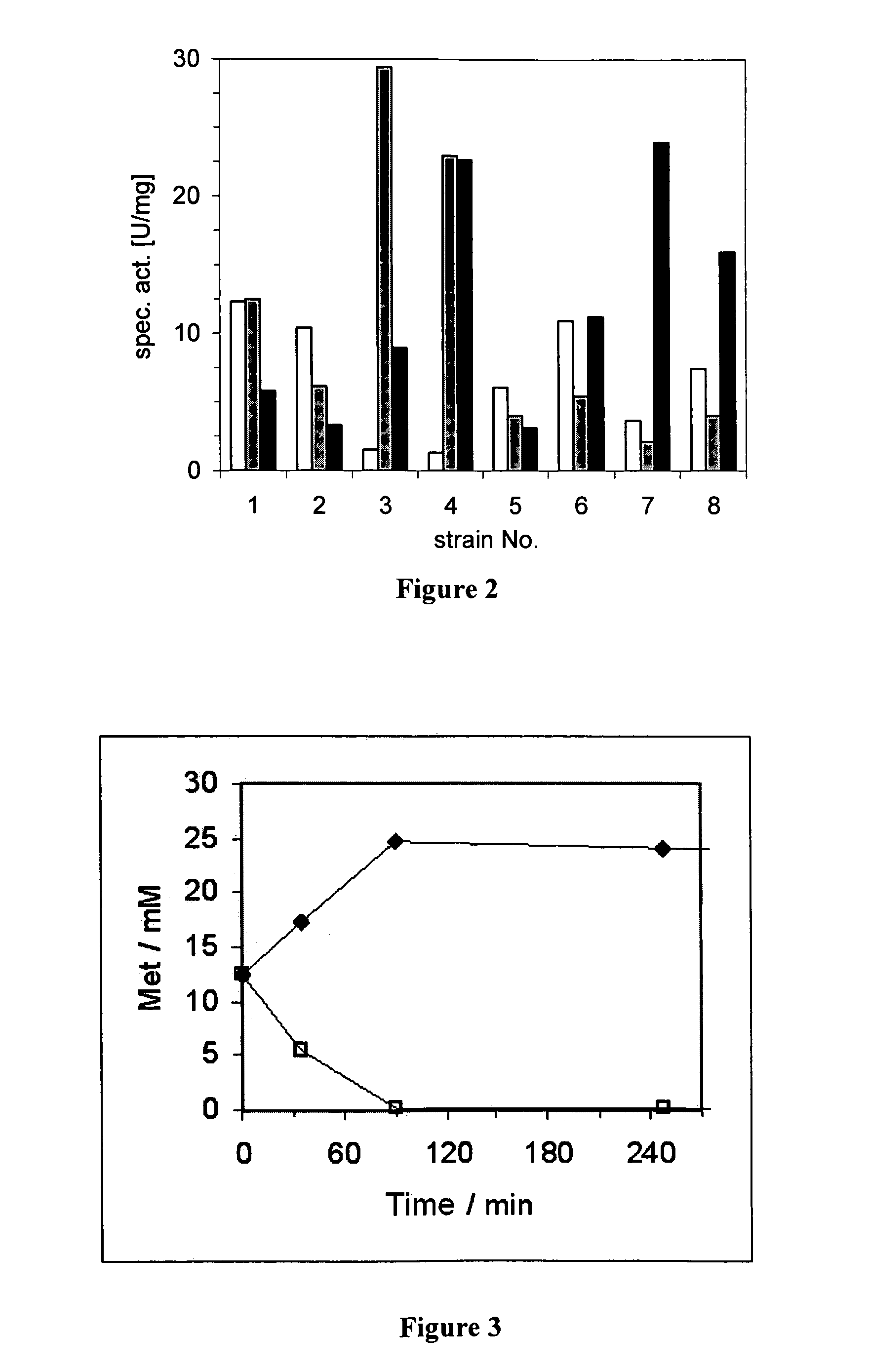Method for the preparation of L-amino acids from D-amino acids
a technology of damino acid and l-amino acids, which is applied in the field of recombinant microorganisms, can solve the problems of high cost of enantiomerically pure amino acids, high cost of options, and high cost of methods, and achieve the effect of making cells permeabl
- Summary
- Abstract
- Description
- Claims
- Application Information
AI Technical Summary
Problems solved by technology
Method used
Image
Examples
example 1
Construction of Plasmids
[0037]A series of plasmids is constructed which carry the genes needed in the conversion process in different combinations: malic enzyme (MAE), leucine-dehydrogenase (LeuDH), D-AAO from arthrobacter protophormiae (ApD-AAO) and D-AAO from trigonopsis variabilis (TvD-AAO). Construction takes place using the primers and plasmids listed in table 3.
[0038]For amplification of the genes of ApD-AAO (Apdao; gi32140775), of TvD-AAO (TVdao; gi1616634) and of malic enzymes (mae; gi1787752) genomic DNA from arthrobacterprotophormiae, trigonopsis variabilis and E. coli K12 is used as templates. The gene encoding leucine dehydrogenase (leudh; gi:6741938) was amplified with the plasmid pT1L (=pLeuB), (Ansorge, et al, Appl. Microbiol. Biotechnol. 53:668–73 (2000)). Using the primers listed in table 3, restriction cut locations were inserted by means of PCR. With the forward primer DAAOTvforNdeI, the intron was removed into the Tvdao gene. In the cloning of Apdao gene in pH1M ...
example 2
Construction of Expression Strains
[0040]Using a suitable combination of plasmids, the recombinant E. coli strains listed in table 4 were constructed. In each case, the strain contains a gene for an amino acid oxidase, a leucine dehydrogenase and a malic enzyme. Starting strains were BL21 (DE3) from Novagen and JM109 from Stratagene.
[0041]
TABLE 4E. Coli StrainsE. coliPlasmidPlasmidResist-No.Strain12Inductorance1BL21(DE3)pAD3LMpE1DIPTGApR, CmR2BL21(DE3)pAD3LMpE2DIPTGApR, CmR3BL21(DE3)pAD2DMpJ1LITPG + RhaApR, CmR4BL21(DE3)pAD2DMpT1LIPTGApR, CmR5JM109pH2DMpJ1LRhaApR, CmR6BL21(DE3)pH2DMpJ1LRhaApR, CmR7JM109pH2DMpT1LIPTG + RhaApR, CmR8BL21(DE3)pH2DMpT1LIPTG + RhaApR, CmR
[0042]The strain designation (1–8) is retained in the following examples of the corresponding table.
example 3
Verification of Intracellular Enzyme Activities
[0043]The strains shown in table 4 are cultured under standard conditions in Luria-Bertani (LB) medium at pH 7.5. Depending on the plasmid transformed, 100 μg ml−1 of ampicillin and / or 34 μg ml−1 of chloramphenicol are added to the medium. For enzyme expression, the recombinant E. coli strains were cultured under aerobic conditions in a 100 ml vibrating flask together with 20 ml of the medium. The cells were incubated at 37° C. at 200 rpm in a vibratory rotating machine and induced at an OD550 of about 0.5 with 100 μM IPTG and / or 0.2% rhamnose. Following this induction the strains were further incubated at 30° C. The enzyme activity measured is presented in FIG. 2 with: white=D-AAO; grey=MAE; and black=LeuDH. Strain 6 shows the effectiveness of the rhamnose promoter.
PUM
| Property | Measurement | Unit |
|---|---|---|
| temperature | aaaaa | aaaaa |
| temperature | aaaaa | aaaaa |
| temperature | aaaaa | aaaaa |
Abstract
Description
Claims
Application Information
 Login to View More
Login to View More - R&D
- Intellectual Property
- Life Sciences
- Materials
- Tech Scout
- Unparalleled Data Quality
- Higher Quality Content
- 60% Fewer Hallucinations
Browse by: Latest US Patents, China's latest patents, Technical Efficacy Thesaurus, Application Domain, Technology Topic, Popular Technical Reports.
© 2025 PatSnap. All rights reserved.Legal|Privacy policy|Modern Slavery Act Transparency Statement|Sitemap|About US| Contact US: help@patsnap.com



